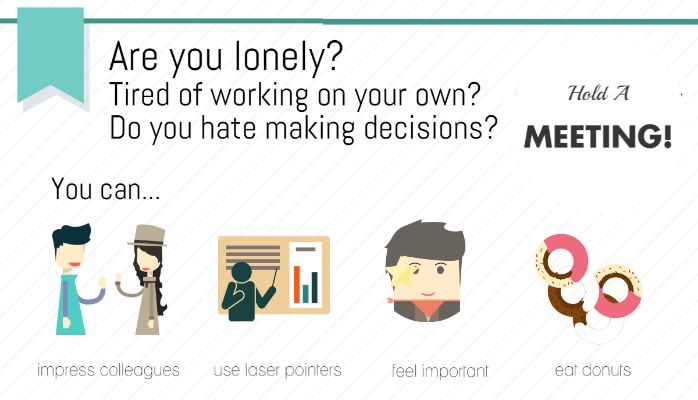Emails, Meetings, and Slides, Oh My!

In the vein of Coté’s White Collar Survival Guides, here are some suggestions of my own for knowledge workers.
The Three Horsemen of the Productivity Apocalypse - and how to slay them
There are a few constants of corporate life that are pretty much universal, and those are email1, meetings, and slides. All three are widely hated, and someone is always trying to kill one or other of them. I have even heard people say that these three factors have ruined their lives.
I would say that the truth is a bit more nuanced. "With great power comes great responsibility", as they say, and certainly all three are powerful tools.
Ah, email. If I had a Euro for every time something had promised to kill email… well, I could start by filling out my dream garage, but I’d still have plenty left over after that. We should probably amend the old saw about only cockroaches surviving nuclear war to include Sendmail running somewhere. Despite everything, it’s still the best tool at its job.
The problem is that most of the time we use email wrong. Email chains devolve into endless back and forth, with unhelpful subject lines like "Re: Re: Fwd: RE: Re: …". This is why, amid all the froth about the latest would-be email killer, I was interested to spot an article discussing how to do email right. In particular, the counter-intuitive recommendation is to write longer emails.
A key rule for e-mail is to keep it brief. The recipients are pressed for time – and perhaps, on their mobiles, cramped for visual space – so keep it to a sentence or two.
Wrong, says productivity expert Cal Newport.
His recommendation is something called "process-centric email":
- When sending or replying to an email, identify the goal this emerging email thread is trying to achieve. For example, perhaps its goal is to synchronize a plan for an upcoming meeting with a collaborator or to agree on a time to grab coffee.
- Next, come up with a process that gets you and your correspondent to this goal while minimizing the number of back and forth messages required.
- Explain this process in the email so that you and your recipient are on the same page.
The desired result is to spend a little more time on each individual message or thread, but reduce the number of visits you need to make to your inbox over time.
This is not that dissimilar to the time-tested format of the VITO letter: grab your correspondent’s attention up front, then articulate your message and the reasons why they should care, and close with concrete actions. Of course you will take more time when writing to an actual VITO than to a run-of-the-mill correspondent, but it’s still an effective tool.
The only problem with both these techniques is that they work well one-to-one, but fall down with those huge sprawling email threads that we all know and love to hate. As more and more people get added to the conversation, skirting Dunbar’s Number, any chance of useful communication breaks down.
Modern tools like Slack can supposedly make this situation better, or at least more tolerable, but the problem there is the requirement that everyone adopt the new tool. As long as not everyone is on the new channel, it’s more trouble than it’s worth to either verify someone is on board or to bring them on board. In time-honoured fashion, people default to just adding more and more people to the same old email chain.
The problem is compounded by the perfect confusion which reigns over email etiquette, with no agreement over who goes in To: and who goes in Cc:, let alone anything about hierarchical ordering of participants.
Still, email is better than all the alternatives, for one simple reason: it works, almost always and almost everywhere. That is a high bar for any new offering to clear, as I have written before.
Meetings

Meetings share many of the same problems as the big multi-user email chains that I was just complaining about. Sure, the attendee list for an in-person meeting is limited by the size of the available meeting rooms - still the most in-demand commodity in any office. Online meetings and conference calls, of course, do not share this limitation.
In either case, though, some attendees may be disinterested, others may be there mainly to be seen, and some may actually be negative. Unless the agenda is enforced ruthlessly, the discussion will move off-topic very rapidly - which anyway is probably a good idea, otherwise why have the meeting in the first place?
One way to optimise the use of meetings comes from Amazon.
In senior executive Amazon meetings, before any conversation or discussion begins, everyone sits for 30 minutes in total silence, carefully reading six-page printed memos.
What makes this management trick work is how the medium of the written word forces the author of the memo to really think through what he or she wants to present.
I have criticised some Amazon quick-fix management practices before, but I think this one makes a lot of sense. In the typical meeting agenda, quite a lot of time is spent level-setting, making sure everyone agrees on the situation to be analysed before proposals can be put forwards. Inevitably, people who are already up to speed - or who think they are - will hijack this process by asking questions, and there are only so many times you can promise to "get to that in just a couple more slides", especially with senior people, before you start losing your audience.
Amazon’s two-stage approach, with the author clarifying their thinking by setting down their analysis and proposal in writing, and the other participants absorbing that message in full before starting to discuss and question it, seems like a really productive way of avoiding the problem.
Sure, it takes a long time to write six-page documents, so maybe save those for the big strategic meetings - but if there is time for a meeting, there should be time for at least a one-page recap of the situation to date, some high-level proposals, and desired outcomes of the meeting. If there is no time to either write or read such a succinct summation, is the meeting really a valuable use of anyone’s time?
Slides
What can I say? I’m a fan of PowerPoint. There, I said it. Much like email, PowerPoint can be (and often is) used wrong, putting audiences at risk of death by PowerPoint, but it’s very effective when used well. Not to blow my own horn, but I get a lot of compliments on my presentations. Partly of course this is because people are used to such a low standard that it doesn’t take much to stand out - and partly it’s because I put thought, preparation, and the results of formal training into my slides. Sometimes this takes a bit more effort than it should, but the results are well worth it.
Invest in a couple of books - I like Slide:ology and Resonate by Nancy Duarte, and of course Presentation Zen by Garr Reynolds. If you can get to a training session, so much the better; talking through this sort of material with an instructor is really effective.
See you at the meeting
I’ll drop you an email about it, and send you my slides afterwards.
Image by Nirzar Pangarkar via Unsplash
-
I’ve given up on hyphenating e-mail since I realised that apart from bills and greeting cards, I receive no physical mail whatsoever, and have not done for some time now. In fact, we could pretty much just go ahead and call it "mail", if it were not for the fact that then you would need a term to describe old-style mail, and "snail mail" is just a bit too precious and insider-y to catch on. ↩